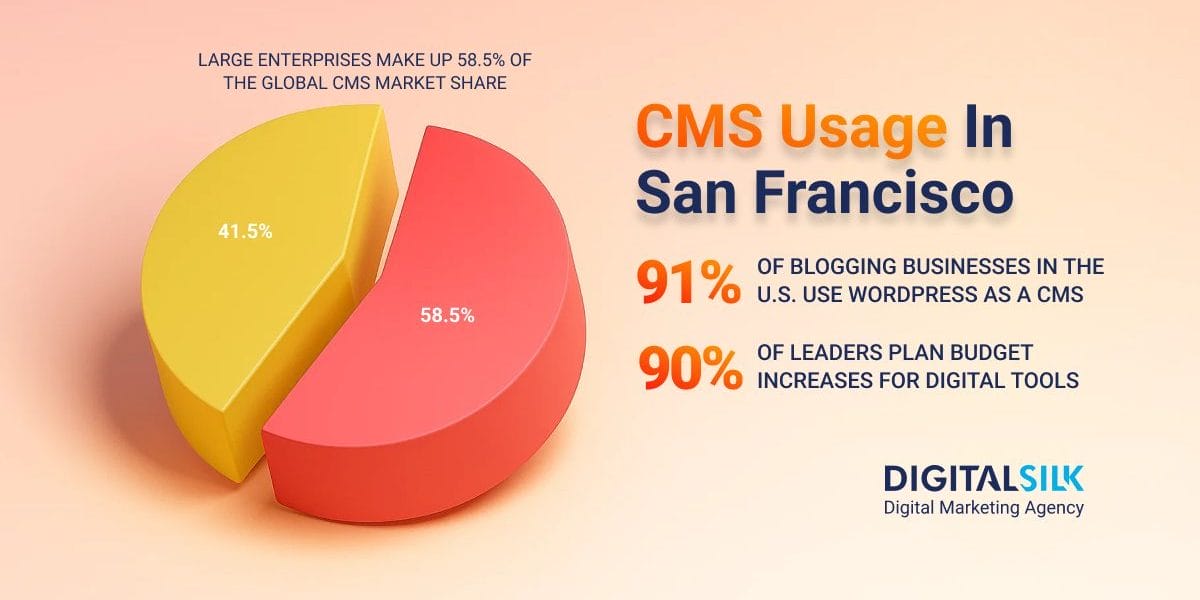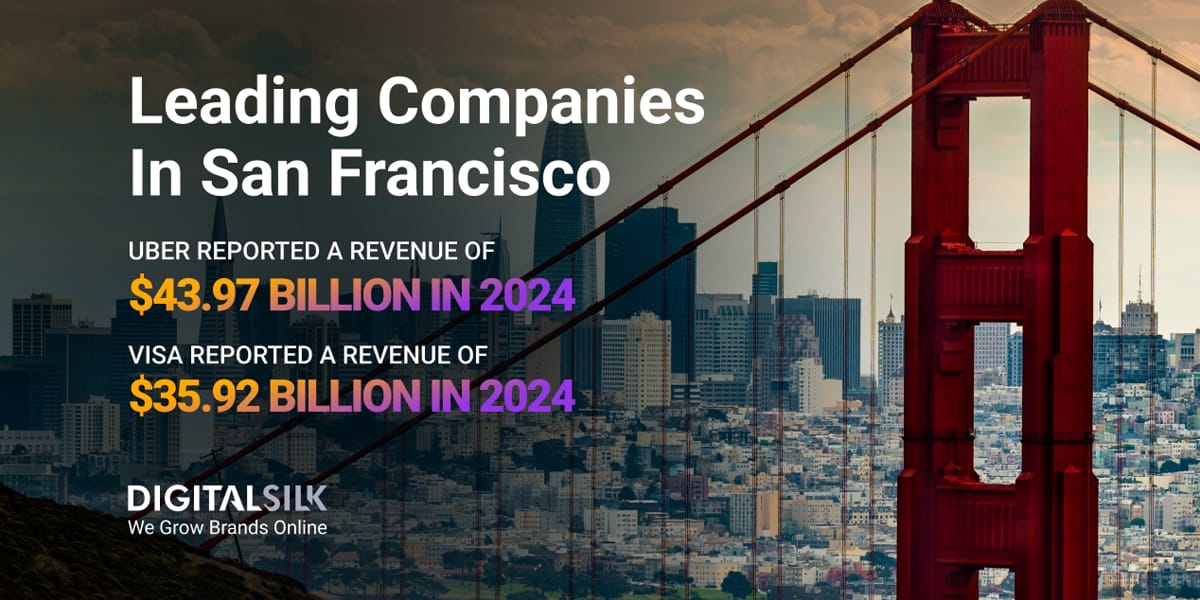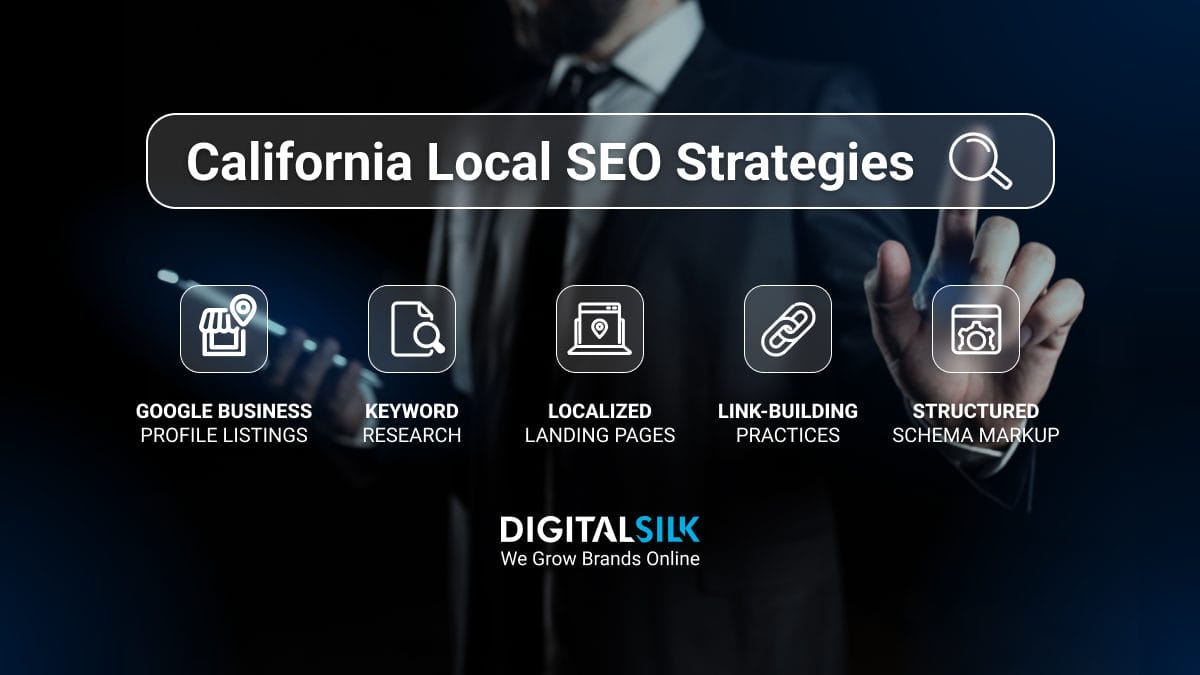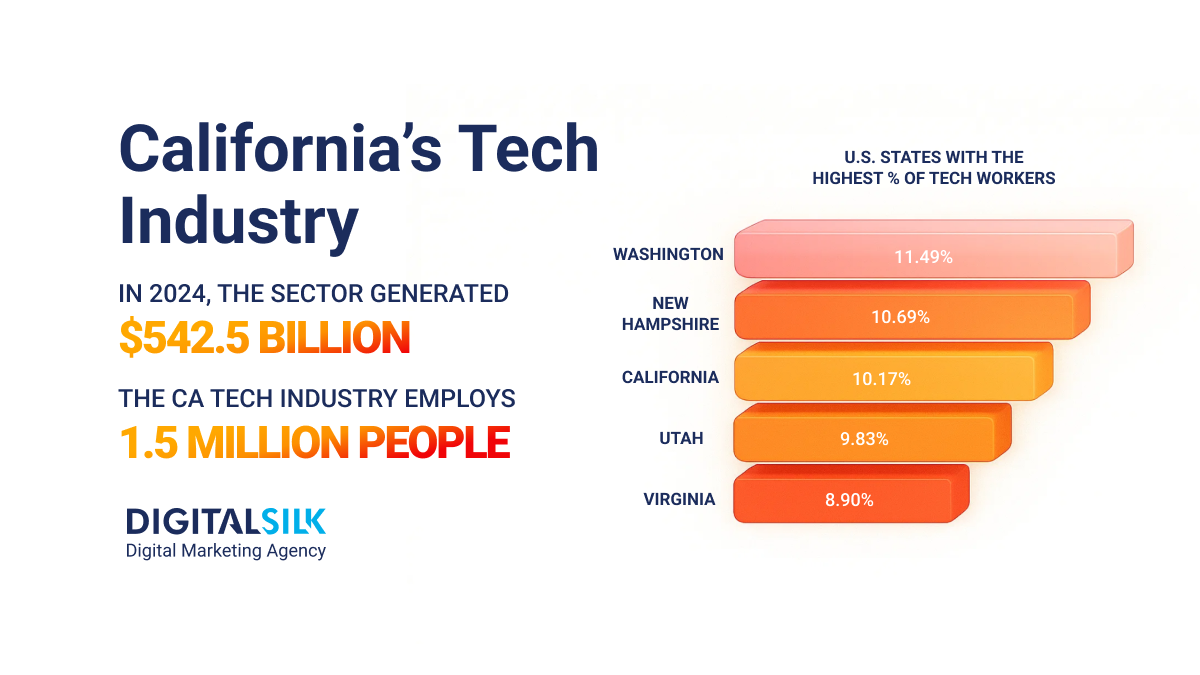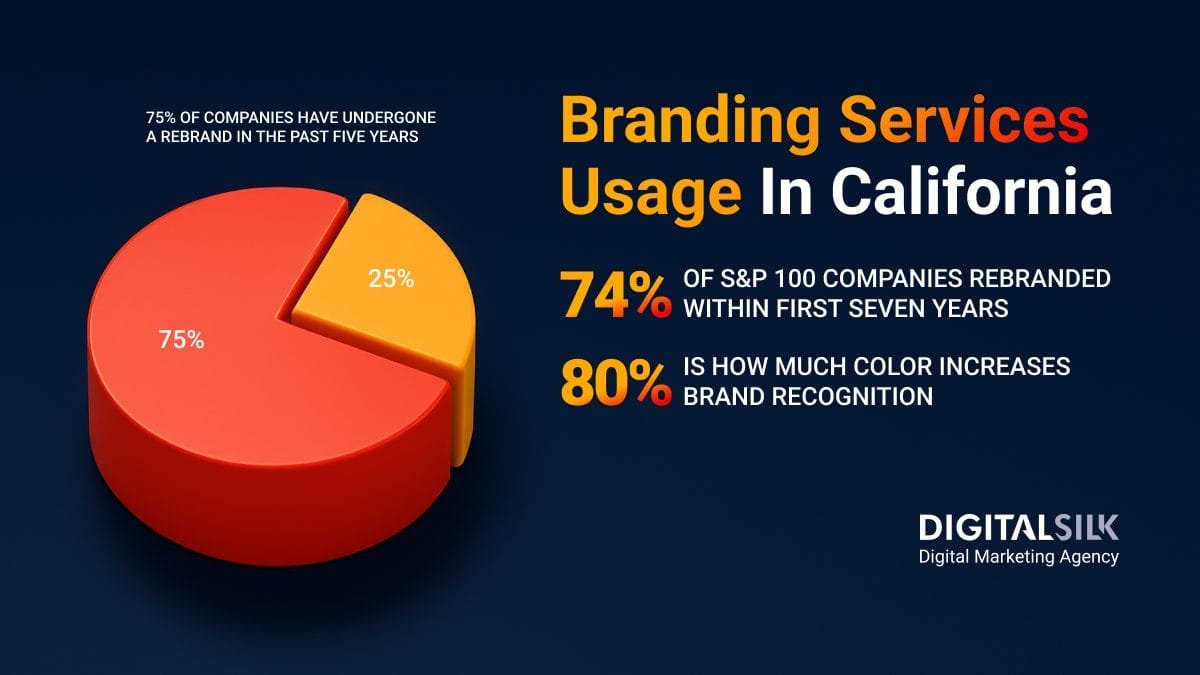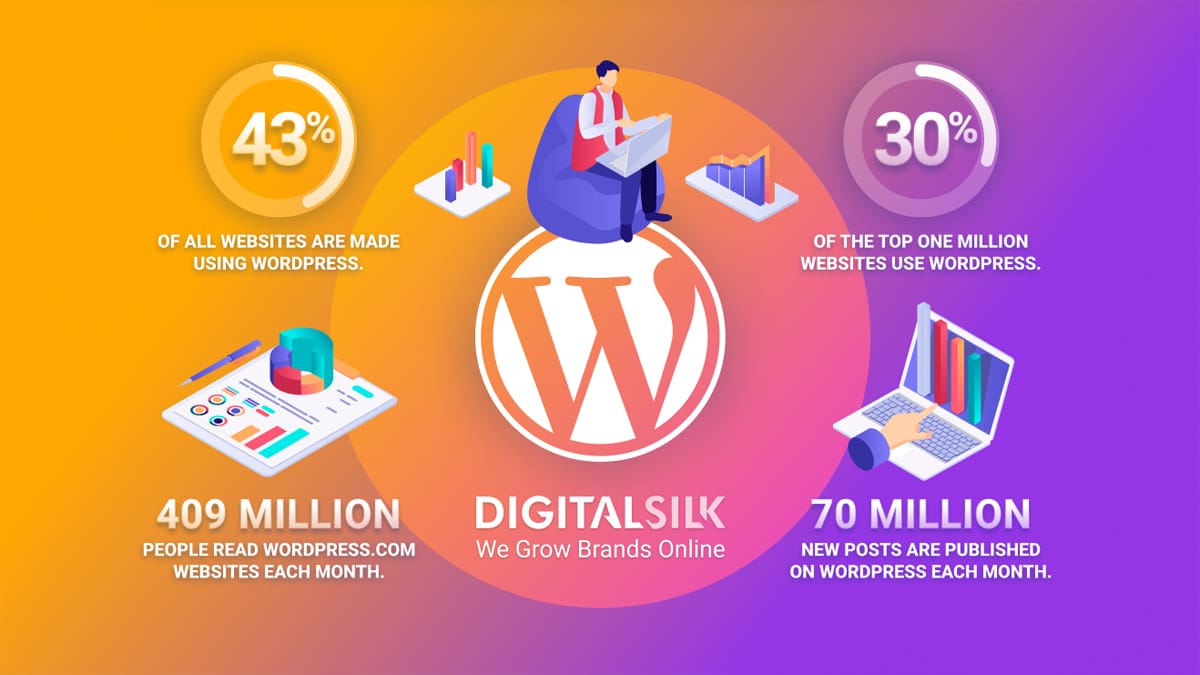Top CMS Platforms San Francisco Enterprises Use: Key Highlights
-
California hosts over 113.000 Squarespace websites, with 8.811 of them based in San Francisco, including brands like Calm and Change.org.
-
90% of technology leaders planned to increase budgets for customer-facing digital products and services in 2024.
-
68% of U.S. organizations have adopted headless CMS, with 98% of the rest planning to evaluate it soon.
Enterprise businesses in San Francisco are making deliberate technology choices that align with their scale, operational demands and growth strategies.
In 2024, enterprises account for 58.5% of the global Content Mangement System (CMS) market, with North America capturing 36.2% of total revenue.
This shift underscores content management’s evolution from a backend utility to a strategic digital asset.
In this post, we’ll dive into the top CMS platforms San Francisco enterprises use and the factors shaping their decisions.
The table below highlights the most popular CMS platforms used by San Francisco-based websites, along with the number of sites using each platform and notable organizations relying on them.
| Platform | Type Of CMS | Number Of SF Websites | Notable Mentions |
| WooCommerce | Open-Source eCommerce | 12.115 | Bootstrap, Mission Local |
| Squarespace | Hosted CMS/Website Builder | 8.811 | Calm, Teespring, Change.org |
| Shopify | eCommerce Platform | 5.804 | GameSpot, Wired, Allbirds |
| WordPress | Open-Source CMS | 1.882 | CNET, Stripe, Wikimedia, X’s URL Shortener |
| Drupal | Open-Source CMS | 703 | Udemi, UserTesting, University Of San Fracisco |
| HubSpot COS | SaaS CMS/Inbound Marketing Platform | 472 | SFGATE, Business Wire, So-Fi |
| Joomla! | Open-Source CMS | 465 | Bitnami, PixelEmu |
| Magento | eCommerce Platform | 117 | The Bar Method, Sprout San Francisco |
| Adobe Experience Manager | Enterprise Digital Experience Platform | 74 | Visa, Splunk, Okta |
| WordPress VIP | Enterprise WordPress Hosting | 68 | Credit Karma, TechCrunch, KFF |
CMS Platforms Market Overview
Enterprise teams are making sharper, more strategic decisions about which platforms power their digital content.
From regional preferences to functional strengths, the definition of the top CMS for enterprises is shifting in response to how businesses produce and scale content.
The following data captures where that shift is happening and which platforms are leading the way.
- The global content management software market is valued at $31.7 billion in 2024 and is on track to reach $57.3 billion by 2030, reflecting a projected CAGR of 10.4% between 2025 and 2030.
- Globally, WordPress leads the CMS category with 61.1% of websites relying on it for content management, while Shopify trails behind with 6.7%.
- At the same time, 28.8% of all websites don’t use any tracked CMS platform, meaning nearly 3 in 10 sites are either static or custom-built and may be missing out on the flexibility and efficiency that modern CMS tools offer.
- In contrast, the U.S. market leans toward Squarespace, which leads with 19% or just over 5 million websites, compared to WordPress at 13% or over 3.5 million sites.
- For U.S. businesses focused on blogging and content, WordPress remains the dominant platform with a 91% share.
What These Numbers Mean For SF Enterprises
- Sticking with outdated or custom-built web infrastructure could limit growth. Enterprises that delay CMS modernization risk operational bottlenecks and reduced flexibility in how they manage digital content.
- CMS selection should be a direct extension of your business model and digital priorities. Enterprises with a strong focus on content publishing will need very different platform capabilities than those centered around ecommerce or lead generation.
- Enterprise teams are prioritizing website performance and operational efficiency. Choosing a CMS that reduces IT dependency and allows faster content updates will help maintain a competitive edge in fast-moving digital markets.
Top CMS Platforms In San Francisco
Choosing the best CMS in 2025 comes down to more than brand familiarity, with businesses prioritizing website performance, conversion rates and return on investment (ROI).
Across the Bay Area, organizations are making platform decisions that align with their industry focus and growth goals.
These numbers highlight where adoption is strongest and how these choices are shaping digital outcomes in the city.
- California hosts 113.195 Squarespace websites and 8.811 of those are in San Francisco, including Calm, Teespring and Change.org.
- 25% of those websites are focused on Arts and Entertainment.
- The Golden State hosts 102.811 Shopify websites, with 5.804 operating in San Francisco, including GameSpot, Wired and Allbirds.
- 31.5% of California-based Shopify stores fall within the Apparel category.
- Golden Gate City represents 12.115 of the 100.229 WooCommerce websites running in California, including Bootstrap and Mission Local.
- Arts and Entertainment is the leading category for 10.1% of WooCommerce stores in California.
- WordPress in San Francisco powers 1.882 websites, part of the 16.964 total across the state, including CNET, Stripe, Wikimedia and X’s built-in URL shortening service.
- Fog City accounts for 703 of the 9.102 Drupal websites currently running across California, including Udemi, UserTesting and the University of San Francisco.
- 46.4% of Drupal eCommerce websites operating in The Bear Flag State are in the Books and Literature space.
- Joomla! adoption in California stands at 8.457 websites, with 465 operating in the City by the Bay, including Bitnami and PixelEmu.
- HubSpot COS powers 3.813 websites in California, with 472 of them based in San Francisco, including SFGATE, Business Wire and SoFi.
- Among the 3.419 sites using Magento for business in California, 117 are in San Francisco, including The Bar Method and Sprout San Francisco.
- 16.2% of Magento sites across California belong to the Health category.
- 1.420 websites across California are built on Adobe Experience Manager, Adobe’s enterprise platform for content management and customer experience, with 74 operating in San Francisco. Notable mentions include Visa, Splunk and Okta.
- WordPress VIP, the enterprise-grade version of WordPress built for high-scale content management, powers 620 websites in California, with 68 of them based in San Francisco. This includes sites like Credit Karma, TechCrunch and KFF.
What These Numbers Mean For SF Enterprises
- Flexibility and speed-to-market are becoming key selection factors. The wide distribution of platforms across San Francisco enterprises reflects a shift toward solutions that allow teams to publish, iterate and optimize faster.
- Niche platforms still hold relevance for specific use cases. Drupal and Magento continue to attract businesses with specialized needs like content-heavy education sites or complex ecommerce catalogs.
- Website performance and conversion-focused decision-making drives platform diversification. San Francisco enterprises are selecting CMS platforms that directly support faster load times, better mobile experiences and streamlined paths to conversion.
Business & Leadership Views On SF Enterprise CMS Use
The top companies in the Bay Area are making CMS decisions that directly impact revenue targets, customer retention and content delivery speed.
As budget allocations shift and demand for headless architecture grows, the CMS platforms San Francisco enterprises use are becoming a key part of both marketing and IT strategies.
The following data highlights where leadership teams are focusing their investments and the challenges they face in execution.
- 90% of technology leaders planned to increase budgets for customer-facing digital products and services in 2024.
- 82% of CMOs agree that headless architecture and modern CMS platforms simplify delivering content consistently.
- 68% of U.S. organizations have already adopted headless CMS systems, which separate backend content from front-end presentation, while 98% of those still on traditional setups intend to evaluate headless options in the next year.
- By industry, Sales, Media and Marketing top the list with 82% adoption, with HR right behind at 81%.
- 60% of business owners believe their organization’s website infrastructure budget will increase in the next year.
- 69% of global B2C leaders say they increased investment in content management technology in 2024, up from 59% in 2023.
- 37% of business leaders point to IT roadblocks as a barrier to content publishing, while 46% report difficulty finding developers who can support their CMS.
- 50% of them say customer retention and expansion is the single most impactful content metric for driving revenue.
- The same survey found that 60% of executives see customer retention and expansion as the most impactful content metric for driving revenue.
- With 37% of websites publishing new content multiple times per day, having a CMS that supports speed and flexibility is no longer optional for content-driven organizations.
What These Numbers Mean For SF Enterprises
- CMS selection should align with revenue and retention goals. With customer expansion and retention now viewed as key revenue drivers, San Francisco enterprises need platforms that make audience engagement and lifecycle marketing easier to execute.
- Headless architecture is moving from trend to standard practice. As more enterprises embrace headless CMS solutions, businesses still on legacy systems risk falling behind in content delivery speed and omnichannel consistency.
- Budget increases for digital infrastructure require platform scalability. As technology leaders plan for larger investments, now is the moment to assess whether your current CMS can scale with your organization’s growth targets.
How San Francisco Businesses Can Choose A CMS Platform
Selecting the right platform is a strategic decision that impacts customer experience, operational efficiency and revenue growth.
The goal is to solve customer pain points faster, overcome common enterprise SEO challenges with actionable strategies and build a website that generates leads at scale.
The steps below offer a framework for evaluating the CMS platforms San Francisco enterprises use most often.
1. Assess Business Needs
Understanding your organization’s content goals, internal workflows and audience expectations is the foundation for making the right platform choice. A platform that aligns with your business model will help reduce operational friction and support long-term scalability.
2. Prioritize Website Performance
Page speed, mobile responsiveness and technical SEO readiness should be central to your decision-making process. A CMS that supports fast load times and clean code can have a direct impact on both search visibility and conversion rates.
3. Evaluate SEO Flexibility
For enterprises competing in dense digital markets, a platform with robust SEO controls is essential. Look for options that offer customizable metadata, flexible URL structures and seamless integration with your analytics tools.
4. Focus On Content Publishing Agility
Frequent content updates require a platform that empowers marketing and content teams to publish quickly without relying on IT support. Opt for intuitive editing tools and streamlined workflows to help your team meet tight campaign deadlines.
5. Review Integration Capabilities
Your CMS should easily connect with the rest of your digital ecosystem. Whether it’s your CRM, marketing automation tools or lead capture forms, strong integration capabilities will help turn website traffic into measurable business results.
6. Plan For Scalability And Enterprise Support
As customer needs evolve and content demands grow, your CMS must scale with you. Prioritize platforms with a track record of enterprise support, reliable uptime and a strong network of development partners familiar with CMS platforms San Francisco enterprises use.
Understanding CMS Architecture: Traditional Vs. Decoupled Vs. Headless
The architecture behind your CMS determines how quickly your team can publish, personalize and scale digital experiences.
For enterprise leaders, understanding the difference between traditional, decoupled and headless CMS options is essential when evaluating long-term ROI and operational agility.
1. Traditional CMS (WordPress, Drupal)
Content and design are tightly linked in a single system. These platforms are user-friendly and ideal for marketing-driven teams that need to publish frequently without developer support.
Best for: Midsize teams with limited IT resources and straightforward content needs.
2. Decoupled CMS (Sitecore, Adobe Experience Manager)
Platforms like AEM or Sitecore in San Francisco separate content management from the front-end presentation, but still allow some platform-controlled delivery. Offers greater design flexibility while retaining built-in features.
Best for: Enterprises with complex branding requirements and cross-platform content needs.
3. Headless CMS (e.g., Contentful, Sanity):
Content is delivered via APIs to any device or front-end system. Offers unmatched speed, scalability and omnichannel consistency, but requires developer support.
Best for: Large organizations with in-house engineering teams prioritizing agility, performance and future-proof architecture.
Build A Website On The Right CMS With Digital Silk
Building an effective website starts with choosing a platform that supports your business goals, content strategy and long-term growth.
With adoption trends and technology expectations evolving rapidly, enterprises need solutions that balance performance, flexibility and ease of use.
Digital Silk follows the latest industry best practices to create tailored website solutions that improve user experience, drive engagement and deliver measurable business results.
As an experienced web design agency, our services include:
- Web design for San Francisco Brands
- Custom web design
- Custom web development
- Branding for San Francisco Businesses
- Digital marketing for San Francisco brands
Contact our team, call us at (800) 206-9413 or fill in the Request a Quote form below to schedule a consultation.
"*" indicates required fields


